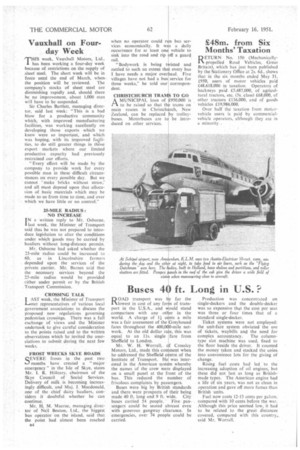Buses 4 ft. Long in U.S.?
Page 38

If you've noticed an error in this article please click here to report it so we can fix it.
ROA D transport was lowest in cost of any fo port in the U.S.A., and comparison with any ot world. A charge of 1 c was a fair assessment of the fares throughout the 400, work. At the old dollar ra equal to an I Is. single Sheffield to London.
y far the of transould stand er in the nts a mile reyhound -mile nete, this was fare from f Crossley ment when ntre of the was inter Mr. W. H. Worrall, Motors. Ltd., made this co he addressed the Sheffield c Institute of Transport. He ested in the American syst m whereby the names of the crew were displayed on a small panel at the front of the bus. This reduced the number of frivolous complaints by passengers.
Buses were big by British standards and there were prospects of their being made 40 ft. long and 9 ft. wide. City
buses carried 54 people. Five passengers could be seated abreast even with generous gangway clearance. In emergencies, over 74 people could be carried.
f Crossley ment when ntre of the was inter Production was concentrated on single-deckers and the double-decker was so expensive that the cost per seat was three or four times that of a standard single-decker.
Ticket systems were not employed: the unit-fare system obviated the use of tickets, waybills and the need for
complex accountancy. The columntype slot machine was used, fixed to the floor beside the driver. It counted the money taken and stacked the coins into convenience lots for the giving of change.
Rising fuel costs had led to the increasing adoption of oil engines, but these did not last as long as Britishmade types. The American engine had a life of six years, was not as clean in operation and gave off more fumes than British units, Fuel now costs 12-13 cents per galion. compared with 10 cents before the war. Although this price seemed low, it had to be related to the great distances covered, compared with this country, said Mr. Worrall.




















































































